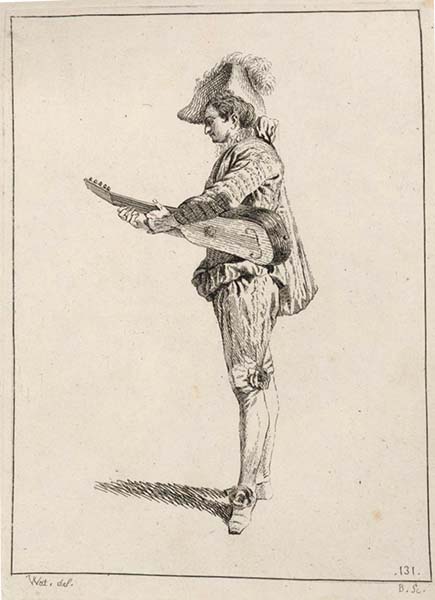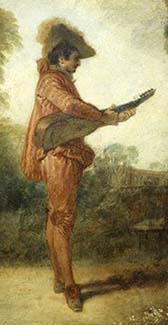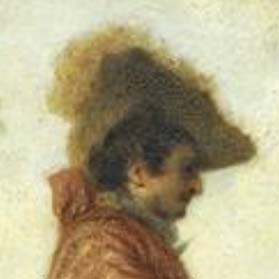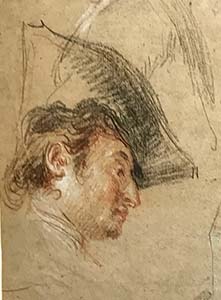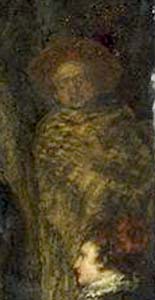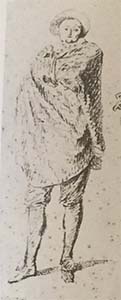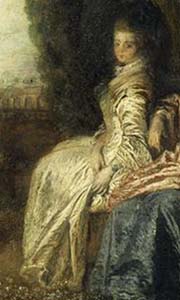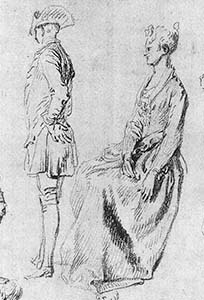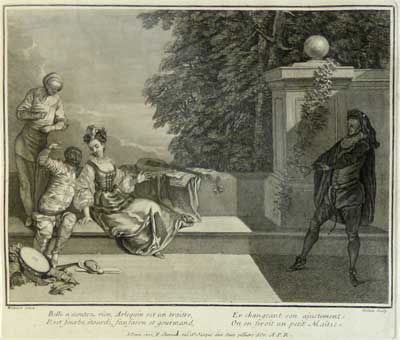
- Home Page
- Accepted
Paintings & Copies - Doubtful
Attributions - Doubtful Textual References
- Alternative
Titles - Collectors &
Museums - Bibliography
- Search Abecedario
- Watteau &
His Circle
L’Enchanteur
Entered August 2021; revised September 2021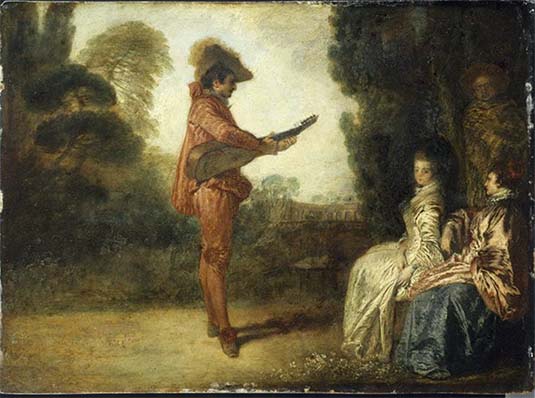
Troyes, Musée des beaux-arts, inv. 835.15
Oil on copper
18.9 x 25.6 cm
ALTERNATIVE TITLES
Die bezaubernde Kavalier
Le Charlatan
Il Charlatano
L’Incantore
Scène champêtre
Sujet espagnole
Der Zauberer
RELATED PRINTS
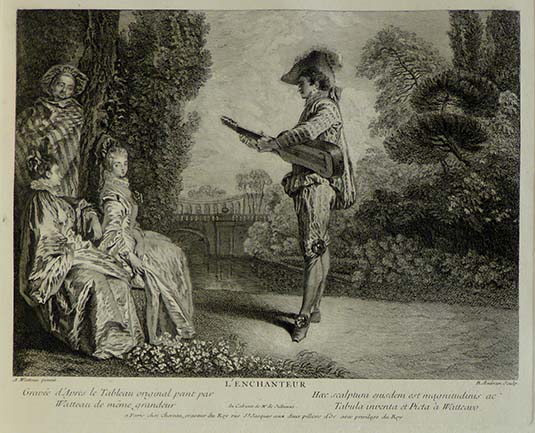
Benoît Audran after Watteau, L’Enchanteur, engraving.
Like its pendant, L’Avanturière, L’Enchanteur was engraved in reverse by Benoît Audran.
PROVENANCE
Paris, collection of Jean de Jullienne (1686-1766; director of a tapestry factory). Jullienne’s ownership is cited on Audran’s engraving after L’Enchanteur, “du Cabinet de Mr de Jullienne.” At some point in the next two decades, he sold the painting to Orry, as explained below. L’Enchanteur is not listed in the inventory of Jullienne’s collection prepared c. 1756, now in the Morgan Library & Museum, New York.
La Chapelle-Godefroy (Nogent-sur-Seine), collection of Philibert Orry (d. 1747; contrôleur général des finances, seigneur de Nogent-sur-Seine).
By descent to Jean Henri Louis Orry de Fulvy (d. 1757).
By descent to Bouret de Valroche (d. 1761).
By descent to Jean de Boullongne (d. 1767).
By descent to Jean Nicolas de Boullongne (d. 1787).
By descent to Paul Esprit Charles de Boullongne.
The collection at La Chapelle-Godefroy was seized during the Revolution. The pendants L’Avanturière and L’Enchanteur were cited in a report delivered at a meeting of the département de l’Aube, where the paintings in a large armoire on the first floor were inventoried: “11o. deux tableaux, sujets espagnols de Watteau.”
Transferred to the Musée des beaux-arts of Troyes, in 1835.
EXHIBITIONS
Geneva, Musée Rath, Trois siècles d’art français (1949), cat. 129 (by Watteau, L’Enchanteur, lent by the Musée des beaux-arts, Troyes).
London, Royal Academy, Landscape in French Art (1949), cat. 83 (by Watteau, The Enchanter, lent by the Musée des beaux-arts, Troyes).
Paris, Galerie Charpentier, Plaisirs de France (1951), cat. 195 (by Watteau, L’Enchanteur, lent by the Musée de Troyes).
Hamburg, Kunsthalle, Meisterwerke der französischen Malerei (1952), cat. 71 (by Watteau, Der Zauberer, lent by the Musée des beaux-arts, Troyes).
Brussels, Palais des beaux-arts, La Femme (1953), cat. 134 (by Watteau, L’Enchanteur, lent by the Musée de Troyes).
Bordeaux, Musée, Paris et les ateliers provinciaux (1958), cat. 39 (by Watteau, L’Enchanteur, lent by the Musée des beaux-arts, Troyes).
Montreal, Héritage de France (1961), cat. 85 (as by Watteau, L’Enchanteur, lent by the Musée des beaux-arts, Troyes).
Tokyo, Musée national d'art occidental, L’Art français du 18ème siècle (in Japanese) (1969), cat. 42 (by Watteau, L’Enchanteur, lent by the Musée des beaux-arts, Troyes).
Brussels, Palais des beaux-arts, De Watteau à David (1975), cat. 1 (by Watteau, L’Enchanteur, lent by the Musée des beaux-arts, Troyes).
Moscow, De Watteau à David (in Russian) (1978), cat. 19 (by Watteau, The Enchanter, lent by the Musée des beaux-arts, Troyes).
Washington, Paris, Berlin, Watteau 1684-1721 (1984), cat. P17 (by Watteau, The Enchanter [L’Enchanteur], lent by the Musée des beaux-arts, Troyes).
Aix, La Passion selon Don Juan (1991), cat. 121 (by Watteau, L’Enchanteur, lent by the Musée des beaux-arts, Troyes).
Taipei, National Palace Museum, De Poussin à Cezanne (2001), cat. P 84 (by Watteau, L’Enchanteur, Musée des beaux-arts et archéologie, Troyes).
Valenciennes, Musée, Watteau et la fête galante (2004), cat. 55 (by Watteau, L’Enchanteur, lent by the Musée des beaux-arts, Troyes).
Brussels, Palais des beaux-arts, Watteau, Leçon de musique (2013), cat. 38 (by Watteau, L’Enchanteur, lent by the Musée des beaux-arts, Troyes).
SELECT BIBLIOGRAPHY
Troyes, Musée, Catalogue (1850), cat. 129.
Hédouin, “Watteau” (1845), cat. 20.
Hédouin, Mosaïque (1856), cat. 20.
Troyes, Musée, Notice sur les collections (1864), cat. 110.
Goncourt, Catalogue raisonné (1875), cat. 130.
Troyes, Musée, Catalogue (1879), cat. 142.
Troyes, Musée, Catalogue (1886), cat. 179.
Babeau, “Musée de Troyes” (1899), 506.
Fourcaud, “Scènes et figures théatrales” (1904), 348.
Zimmerman, Watteau (1912), pl. 26.
Dacier, Vuaflart, and Hérold, Jean de Jullienne et les graveurs (1921-29), 3: cat. 11.
Réau, “Watteau” (1928), cat. 102.
Troyes, Musée, Catalogue (1929).
Barker, Watteau (1939), 52.
Brinckmann, Watteau (1943), 19, pl. 19.
Adhémar, Watteau (1950), cat. 123.
Mathey, Watteau, peintures réapparues (1959), 68.
Gauthier, Watteau (1959), pl. 16.
Mirimonde, “Sujets musicaux chez Watteau” (1961), 261, 270.
Vergnet-Ruiz and Laclotte, Petits et grands musées (1962), 70, 256.
Mirimonde, “Musiciens isolés et portraits” (1966), 144-45.
Macchia and Montagni, L’opera completa di Watteau (1968), cat. 88.
Ferré, Watteau (1972), 1: 98-99; 3: 964-65, cat. A13.
Roland Michel, Watteau (1981), cat. 127.
Roland Michel, Watteau (1984), 210, 222, 265, 273.
Posner, Watteau (1984), 153.
Sainte-Marie, Peintures (1986), 29-30.
Rosenberg and Prat, Watteau, Catalogue raisonné des dessins (1996), cat. 146, 609, R 159, G50.
Temperini, Watteau (2002), 40, cat. 23.
London, Tate Britain, Turner and the Masters (2009), 201.
Glorieux, Watteau (2011), 152.
RELATED DRAWINGS
The figure of the standing guitarist in L’Enchanteur was based on a drawing that has not survived, but is recorded in an engraving in the Figures de différents caractères.
An additional study of the guitarist’s head appears on a sheet of studies of men’s and women’s heads in the Petit Palais (Rosenberg and Prat 609). The angle of the profile, the burst of light around the ear, the silhouette of the hat—all these correspond exactly. However, despite the closeness of the drawn and painted heads, the relationship is problematic. Rosenberg and Prat argue that Watteau used this study not for the Troyes painting but for the Brodick Castle version of the composition (our copy 1). That said, it seems undeniable that this study also served for the Troyes painting. The problem is that the painting was created before the drawing. Rosenberg and Prat’s date of c. 1717-18 for the drawing is reasonable. Moreover, the drawing of the standing guitarist already shows a similar head in profile. How can this conundrum be resolved? Did Watteau turn back to his painting years after he first finished it in order to retouch areas? A cleaning and laboratory examination of the painting would be useful.
A sheet of four studies of actors (Rosenberg and Prat 146) includes, at the left, a sketch of a comic character that was used in reverse for the actor standing in the shadows at the far right of L’Enchanteur. He is an actor who, as François Moreau has explained, cannot be called a stock character. Yet he appears in just this pose, his arms folded beneath his striped cape, in other Watteau paintings such as L’Amour au théâtre italien.
Until now it has gone unnoticed that the woman in white in L’Enchanteur is based on a sketch on a sheet of studies now in the Musée des beaux-arts, Dijon (Rosenberg and Prat 137). Both women are seated in profile and the positions of their arms and hands are the same: the right arm bends across the lap and the left arm hangs limply at the side. In the course of painting, Watteau modified the figure, turning the head to face us, and changed her left hand to grasp some of the skirt—thus changing the pattern of the folds. These slight changes so transformed the figure that they obscured the underlying relationship.
Because Watteau made an oil counterproof from the pendant painting, L’Avanturière, one might well wonder if he did not make one from L’Enchanteur. But there is no evidence that he did, nor is there any reason to conclude that Watteau worked so systematically. Yet the question is worth considering.
REMARKS
There has been almost unanimous agreement that this painting and its pendant, L’Avanturière, also in the Troyes museum, are autograph versions by Watteau and are the same pictures that Audran engraved in 1727. Their unbroken provenance within the Boullongne family and their entrance into the Troyes museum is almost unique, rivaled only by a few Watteau pictures such as the Louvre’s Pèlerinage.
Nonetheless, there have been naysayers. Edmond de Goncourt thought that the versions he knew of from reading the Vivant Denon 1826 sale catalogue (L’Enchanteur and L’Avanturière, copies 1) were the originals and that the paintings in Troyes were just “esquisses” by Watteau. Not until a century later was there revived interest in the ex-Denon copies. When the Troyes paintings were shown in 1949, their attribution to Watteau was upheld, but curiously they were described as variants of the ex-Denon paintings, implying that the latter pictures had priority. Presently, most Watteau scholars accept the Troyes paintings as having primacy, but a surprising number of critics—including Rosenberg and Temperini—interpret the ex-Denon paintings as slightly later, autograph copies.
The Troyes paintings are in an unfortunate state of preservation, a condition that de Goncourt lamented a century and a half ago, and that modern critics have acknowledged. The paintings are heavily overpainted, covered with an even coat of pigment that obscures the sharpness and definition of forms that we would expect of Watteau. Although superficially colorful, their appearance is misleading.
Although not necessarily the very first fête galante that Watteau painted, a claim that has been made by several authors, L’Enchanteur can be favorably compared with a number of Watteau’s earliest compositions. One of the most compelling comparisons is with his Belle n’ecoutez rien, a painting recorded in Jean de Jullienne's Oeuvre gravé. The pictorial formula is essentially the same: a narrow shelf of space with several figures at one side, facing a single character. The background in Belle n’ecoutez rien is a separate space, a painted backdrop that the characters cannot access; while there still is a distinction between foreground and background in L’Enchanteur, the transition between the two is more subtle, creating the illusion of a continuous space and a credible garden. It might be argued that the two paintings have different sujects. Belle n’ecoutez rien is manifestly a theatrical scene with commedia dell’arte characters, but in fact L’Enchanteur shows theatrical personages as well: the guitarist in his red finery and the Mezzetin in his striped costume at the far right belong to the theatrical world. However, they move quietly and inwardly, more like the people in Watteau’s mature fêtes galantes, and less like the gesticulating actors in his early, explicitly theatrical scenes.
There has been general agreement that L’Enchanteur and its pendant are early works but, as always, there has been little consensus as to what “early” signifies. Zimmerman suggested a range of dates between 1710 and 1716.; Adhémar dated the pictures to 1712-15; Posner preferred 1712-13; Mathey listed them as c. 1713; Roland-Michel cited c. 1713-14; Rosenberg and Glorieux chose c. 1712-14.
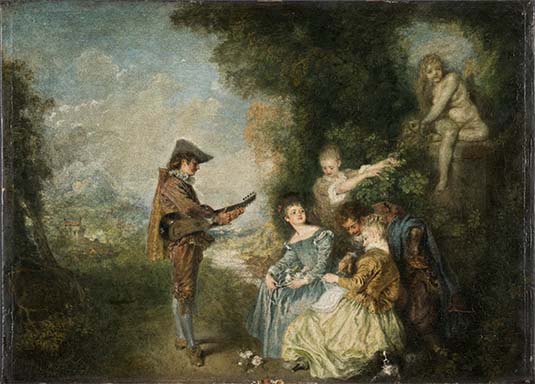
Watteau, La Leçon d’amour, oil on panel, 43.8 x 60.9 cm. Stockholm, Nationalmuseum.
Later in his career Watteau reworked this composition in his Leçon d’amour. The narrative of a guitarist serenading a group of men and women remains in place, the intimacy of a foreground garden and a distant landscape are essentially the same. But what a difference as well! The psychological warmth of the characters, the suavity of their gestures, the sumptuous sense of color, the richness of the landscape—all these factors, not readily apparent in L’Enchanteur, demonstrates the flowering of his art.
Despite the general agreement that L’Enchanteur and its pendant are early works, there has been little consensus as to what “early” signifies. Zimmerman suggested a wide range: between 1710 and 1716. Adhémar dated the pictures to 1712-15. Posner preferred 1712-13, Mathey listed them as c. 1713, Roland-Michel cited c. 1713-14, while Rosenberg, Temperini, and Glorieux chose c. 1712-14.
For copies of L’Enchanteur CLICK HERE
